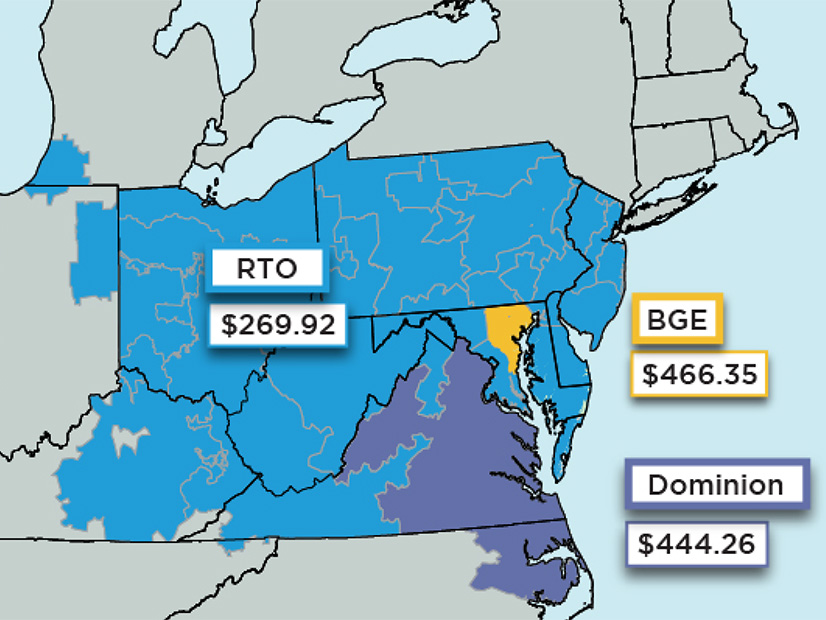The U.S. Department of Energy on Aug. 6 announced its second round of grants for the Grid Resilience and Innovation Partnerships (GRIP) program, with $2.2 billion going to eight projects that could expand grid capacity, reliability and flexibility across 18 states.
Funded with $10.5 billion from the Infrastructure Investment and Jobs Act, the GRIP program is aimed at supporting “transformative” projects that will “enhance grid flexibility and improve the resilience of the power system against growing threats of extreme weather and climate change,” according to DOE.
Announced in October, the first round of awards totaling $3.46 billion was focused primarily on improving grid resilience against extreme weather events at the distribution level, Energy Secretary Jennifer Granholm said during an Aug. 5 press briefing. (See DOE Announces $3.46B for Grid Resilience, Improvement Projects.)
The second tranche announced Aug. 6 is “specifically focused on transmission lines themselves, building more than 600 miles of new lines and reconductoring more than 400 miles of existing lines,” Granholm said. “Altogether, those upgrades are going to add nearly 13 GW of capacity to the grid … to meet the needs of electrified homes and businesses and new manufacturing facilities and all of these growing data centers that are placing demands on the grid. …
“The first half of 2024 has already broken records for the hottest days in Earth’s history, and as extreme weather continues to hit every part of the country, we must act with urgency to strengthen our aging grid to protect American communities,” Granholm said in a DOE press release.
According to DOE, six of the projects will be using the GRIP grants to deploy grid-enhancing technologies (GETs) to expand capacity on existing lines. For example, California is getting more than $600 million to upgrade 100 miles of transmission with advanced conductors and dynamic line rating technology to increase the amount of renewable energy on the grid.
Similarly, a $57 million GRIP award will go to the North Carolina Department of Environmental Quality, which will partner with Duke Energy to upgrade a key transmission line with advanced conductors that will increase capacity and improve resilience as electricity demand continues to grow in the eastern part of the state.
Advanced conductors have a stronger core that can operate at higher temperatures than traditional grid lines, which allow them to carry more power. Dynamic line rating technologies allow grid operators to determine how much power a line can transmit based on real-time conditions rather than using a preset, static rating.
Of the projects building out new lines, Montana was selected to receive the largest award, $700 million, to support the North Plains Connector (NPC), a 415-mile HVDC line running from Montana to North Dakota. It will be the first transmission project that will connect three regions — MISO, SPP and the Western Interconnection — with bidirectional power flows that could open up 3,000 MW of new capacity, as detailed in DOE’s project description.
The project will also help the Standing Rock Sioux Tribe develop wind power on their land.
That broad regional coverage could provide benefits by connecting meteorologically diverse regions that have demand peaks at different times of the day or in different seasons, according to a recent study by Astrapé Consulting. The difference in generation and load profiles could improve the grid’s reliability on both sides of the project without adding any new capacity, project developer Grid United said. (See Study: Significant Benefits for Merchant Tx Line.)
All GRIP awards are supported by public-private partnerships, with individual states and their commercial partners at least matching or exceeding the federal funds. The $700 million for NPC is being matched with close to $2.9 billion in other funding, according to DOE.
DOE estimates the projects will create about 5,000 jobs, with six of the eight projects partnering with local labor unions.
Getting GRIP Projects Permitted
Other GRIP awards will support initiatives that tackle critical grid challenges, including responding to rapidly growing demand from data centers and connecting offshore wind projects to onshore lines.
Home to the greatest concentration of data centers in the country, Virginia is receiving $85.5 million for a project that will build up distributed energy resources at data centers to provide flexible power to the grid. The funds will go to install battery energy storage systems at the Iron Mountain data center in Manassas, Va., and to deploy solar, storage and a natural gas turbine at the Grace Complex, an industrial innovation hub being developed in Lancaster, S.C.
A $389.3 million grant is going to Power Up New England, a joint project of six new England states, ISO-NE and public utilities that will provide new substations in Southeast Massachusetts and Southeast Connecticut to connect up to 4,800 MW of offshore wind power to the onshore grid. And Northern Maine will get a long-duration energy storage system with multiday capacity to improve grid resilience and the integration of renewable energy.
“With Power Up, we are shifting the way we bring offshore wind into our grid,” said Rebecca Tepper, Massachusetts’ secretary for energy and environmental affairs. “We’ve done the hard work to coordinate with ISO New England and developers to ensure we’re making smart, targeted investments to ready our electric grid.”
Speaking at the Aug. 5 press briefing, both Granholm and National Climate Advisor Ali Zaidi said Power Up and other GRIP projects would benefit from DOE’s efforts to streamline and accelerate federal permitting processes, such as the Coordinated Interagency Authorizations and Permits (CITAP) program announced in April.
Under the initiative, DOE will take the lead on permitting transmission projects and coordinate environmental and permitting processes between federal agencies, with a goal of limiting permitting timelines to two years. (See DOE CITAP Initiative Aims to Permit New Transmission in 2 Years.)
Reconductoring projects may be eligible for categorical exclusions, the lightest level of environmental review, under revisions to permitting rules DOE released also in April, providing “a permitting ecosystem that has been vastly improved,” Zaidi said.
Responding to a reporter’s question, a senior DOE official declined to speculate on the potential impact of the bipartisan permitting bill authored by Sens. Joe Manchin (I-W.Va.) and John Barrasso (R-Wyo.), respectively the chair and ranking member of the Senate Energy and Natural Resources Committee.
The Energy Permitting Reform Act of 2024 would increase FERC’s power to authorize new transmission projects and require interregional transmission planning. The bill passed the committee on a 15-4 vote on July 31, days before Congress adjourned for its August recess. The Senate will have three weeks to pass the bill before Congress again goes into recess for the election. (See Manchin-Barrasso Permitting Bill Easily Clears Committee.)
DOE favors removing barriers to permitting and accelerating the ability to do concurrent environmental reviews, the official said, adding that the department is even doing a pilot on using artificial intelligence on permitting.
A third round of GRIP awards will be announced this year or early in 2025 for two other programs under the initiative, DOE said. The Grid Resilience Utility and Industry Grants will target private sector efforts to upgrade the grid, and Smart Grid Grants will support technologies that expand grid capacity.

